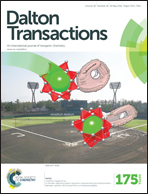Microporous aluminophosphates synthesized with 1,2,3-trimethylimidazolium and fluoride†
Abstract
The synthesis of microporous aluminophosphates using 1,2,3-trimethylimidazolium (123TMI) and fluoride produces three phases (HPM-3, PST-27 and triclinic AlPO4-34) depending on the amount of water and organic structure-directing agents in the synthesis mixture. Fluoride occluded in double 4-ring units was not detected by 19F MAS NMR spectroscopy in any product. While the structure of HPM-3 remains unknown, PST-27 has been determined to be a monoclinic version of AlPO4-5 with a distorted and likely complex structure. Rietveld analysis using synchrotron diffraction data for as-made triclinic AlPO4-34 reveals that each of its cha-cages holds two 123TMI cations, forming a displaced anti-parallel dimer with a short distance between aromatic rings (3.78 Å from center to center, 3.63 Å from plane to plane). This suggests that π–π interactions may play a role in the synthesis of this phase and related CHA-type systems. A study of the optical properties of PST-27, AlPO4-34 and other materials containing 123TMI cations shows their complex fluorescence behavior, sometimes displaying a red-edge effect, i.e., a red shift of the fluorescence as the excitation wavelength is shifted toward the red edge of the absorption band. An absorption band at 291 nm appears only in the dimer-containing triclinic AlPO4-34 and is sensitive to the introduction of Si into the framework.


 Please wait while we load your content...
Please wait while we load your content...